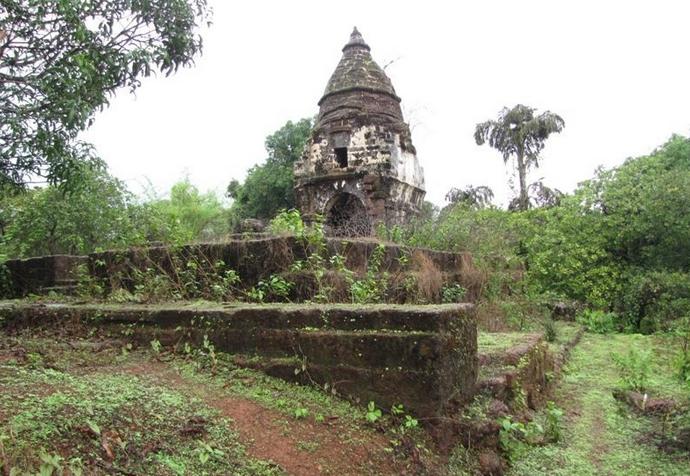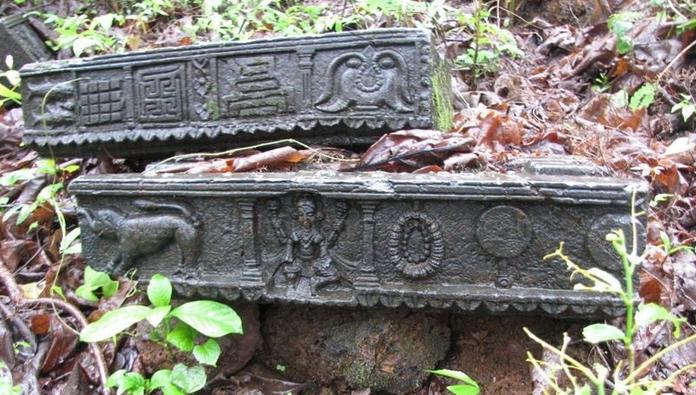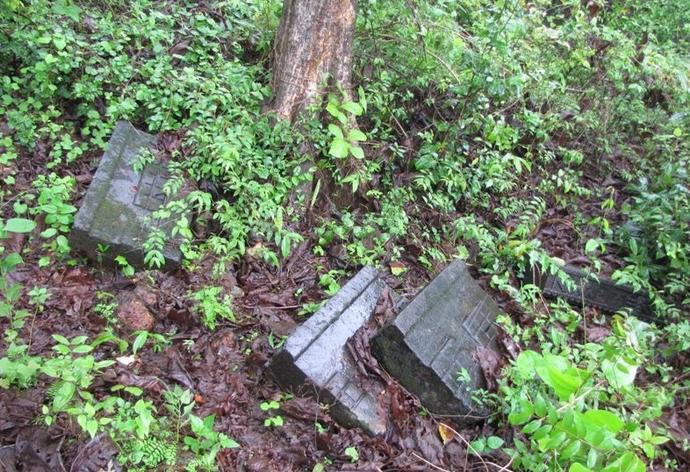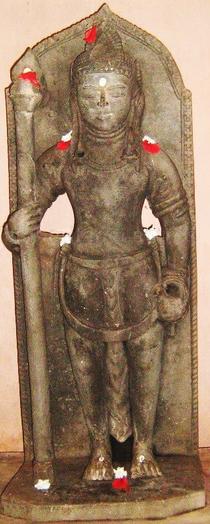Ancient and Modern Jain Temples at Goa
HistoryGoa, the smallest state of India is known for its beaches, places of worship and world heritage architecture. It also has a rich flora and fauna, owing to its location on the Western Ghats range, which is classified as a biodiversity hotspot. The state remained as a part of the Portuguese overseas territory for almost 450 years until it was annexed to the Indian Union in 1961 as an union territory. It was latter elevated as the 25th Indian state on May 30th, 1987.

Stone sculpture of Yaksha Kubera, found in Chandreshwar Temple at Kothambi
Traces of Jainism in Goa
Recent Archeological excavations have unearthed evidence of the existence of Jainism in Goa. During the pre-Portuguese period, there were settlements of the Jain trading community in areas like Bandoda, Gujirwada in Kudne, Kothambi and Narve, which disappeared during Portuguese rule. There are ruins of three Jain temples belonging to Vijayanagar period. The first Jain Basti of Neminath is from Bandivade of Ponda taluka. The other two Jain temples located in Cudnem and Jainkot area of Narve belong to the Vijayanagar period.
Further, the popular word in Goa ‘Shivarak’ meaning vegetarian food is evolved from the Jaina word ‘Shravak’ which means Jain house holder.
Neminath Jain Basti at Bandivade
Neminath Jain Basti is situated at Bandivade near Ponda in North Goa District. The temple is dedicated to Lord Neminath, the 22nd Tirthankara. A stone inscription from Nagueshi exhibited in the Museum of Archaeological Survey of India refers to the reconstruction of this Jain Basti during Vijayanagar period in 14th century. Further, the Kannada inscription of Bandivade mentions that king Sripala established Bandivade in Ponda and constructed the Neminath Jain Basti. The inscription records the gift of Vaghurme made in 1425 A.D. and 1433 A.D. to Jain basti of Bandivade.
The square shaped temple is built of laterite blocks with grilled windows. An arch provided at the entrance indicates the existence of a dome over the structure. Lime mortar is found to have been used extensively in its construction. Ponda, the administrative headquarters of Ponda taluk lies about 28 km south-east of Panaji and 17 km north-east of Margao.
Cudnem Jain Temple
Cudnem is an erstwhile town of the Chalukyan period situated in Bicholim taluk of north Goa district. It is located within 3 km from the Aravalem Caves. An ancient Jain temple belonging to the Vijayanagar period is an important landmark. Recent excavations have unearthed a few interesting structures: the temple consists of a mukhamandapa and a garbagriha, constructed of laterite on a two meters high platform. The 8 x 8,3 meters mukhamandapa consists of four pillars in the center and four others on each side wall; it has a gabled roof with tiles. The laterite blocks discovered during the excavations indicate the existence of arches in the mukkamandapa. These arches were probably constructed with a laterite floral pendant at the center of each arch. One such floral pendant has been discovered in a recently conducted excavation. The presence of these arches strongly suggests that there was an overlying dome covering the temple.

Cudnem Jain Temple
The entrance of garbagriha has an arch, the octagonal shikhara of the garbagriha has five tiers. The lower most is half spherical with a rectangular small entrance for the garbagriha. A broken stone head of a tirthankara with beautifully sculpted curls was also found near the garbagriha. A stone torso of a Jain tirathankara with a srivatsa symbol was also unearthed. While desilting a well in the vicinity of the temple, at a depth of five meters, the right leg of a Statue was discovered. It appears that the broken head and the leg belonged to the same image. The sculptural structure of the idol indicates that the temple belongs to the Kadamba period. A lot of lime mortar found during the excavations indicates its use as a binding material. This is the only medieval temple of Goa which has a nagara (Indo-Aryan) architectural feature. The high platform and the tall shikhara give a sense of soaring height to the temple. A prakara wall with a base of pillars has also been unearthed. This Jain temple is similar to the Saptakoteshwar Temple of Narve and the Chandranath Temple of Paroda. It is possible that this temple was the forerunner of these architecturally similar temples.

Cudnem Jain Temple
In January 1684, the army of Mughal ruler Aurangzeb burnt Bicholim town and destroyed the temple of Ramchandra at Pilgao. Historians opine that this might along have been demolished around the same time.
Narve Jain Temple
The ruins today called as “Jain khot” are located in the Village of Narve in Bicholim taluk. They lie very near the present Hindu temple of Saptakoteshwar. In front of the Saptakoteshwar temple, there is ancient pathway constructed of locally available laterite slabs which lead to the ruins of Jain temple. These consist of mainly door jams, ceiling canopy and lintels chlorite schist. The Jain temple was built of laterite. Lime mortar has also been noted to have been used extensively here.

Narve Jain Temple (also known as "Jain Khot")
One of the reference to the temple from an inscription found on the pedestal of a headless Suparshvanatha idol indicates the name of “Suparshwanath” along with the name of the month and day, corresponding to the English calendar date of March 13th, 1151 AD, (period of the Kadambas and King Vijayaditya or Permadideva or Shivachitta). Another sculpture of Parshvanath too was discovered at Hindolewada in Narve recently.

Narve Jain Temple (also known as "Jain Khot")
Ancient Jain idols
- The broken Jain sculpture of a Tirthankara discovered by Fr. Henry Heras in Chandor of Salcete belongs to the early Southern Silahara period.
- The stone sculptures of Kubera and a Jain Tirthankara, found in the temple of Chandreshwar at Kothambi in Bicholim, belong to the southern Silahara period.
- Another broken sculpture of a Tirthankara was found in a well adjacent to the temple of Betal in Cudnem. This belonged to the southern Silahara period.
Other Traces of Jainism
Kamleshwar temple from Korgao in Pernem has a Jain idol as the affiliated deity. Korgao had Jain carpenters who were worshiping a deity called "Kuvaleshwar" as a Jain Tirthankar.

Kuvaleshwar
Modern Jain Structures
The Jain community in Goa is very small with a population of 820 people (as per 2001 census); it constitute to about 0,1 % of the states population. We can find a Digambar Jain Temple, a Shvetambar Murthipujak Temple and a Jain Sthankawasi Upashraya.
- Goa Digambar Jain Temple
The bhumi puja for the Digambar Jain Temple in Goa was held on the 30th of January, 2005 in the presence of Swasti Sri Lakshmisena Bhattarakha Swamiji of Kolhapur Jain Mutt. The construction of the temple was undertaken in the auspices of the Digambar Jain trust. The panchakalyana pratishta mahotsava of the temple was conducted in October-November 2008 at Mugali-Davarli near Margao. The pratishta mahotsava was held under the guidance of Muni Sri 108 Shanthi Samarpansagarji Maharaj and Sri Charukeerthi Bhattarakha Swamiji, the pontiff of the Digambar Jain Mutt, Moodabidri. This temple has the idol of Lord Adinatha as the main deity.
- Goa Shvetambar Jain Murtipujak Temple
There is a Shvetambar Murtipujak temple, dedicated to Lord Sumathinatha in the Madgaon area of Goa. We can find a pravachan hall and dharmashala besides the temple.
- Goa Jain Sthanakwasi Upashraya
The inauguration of the Jain Bhavan complex along with the upashraya and other facilites was held on 3rd January, 2001. The ceremonies were conducted under the presence of Guruji Bhavchanraji Swami, Mahasatiji Reshmibai and accompanying Maharajsahebs.
 Nitin H.P.
Nitin H.P.